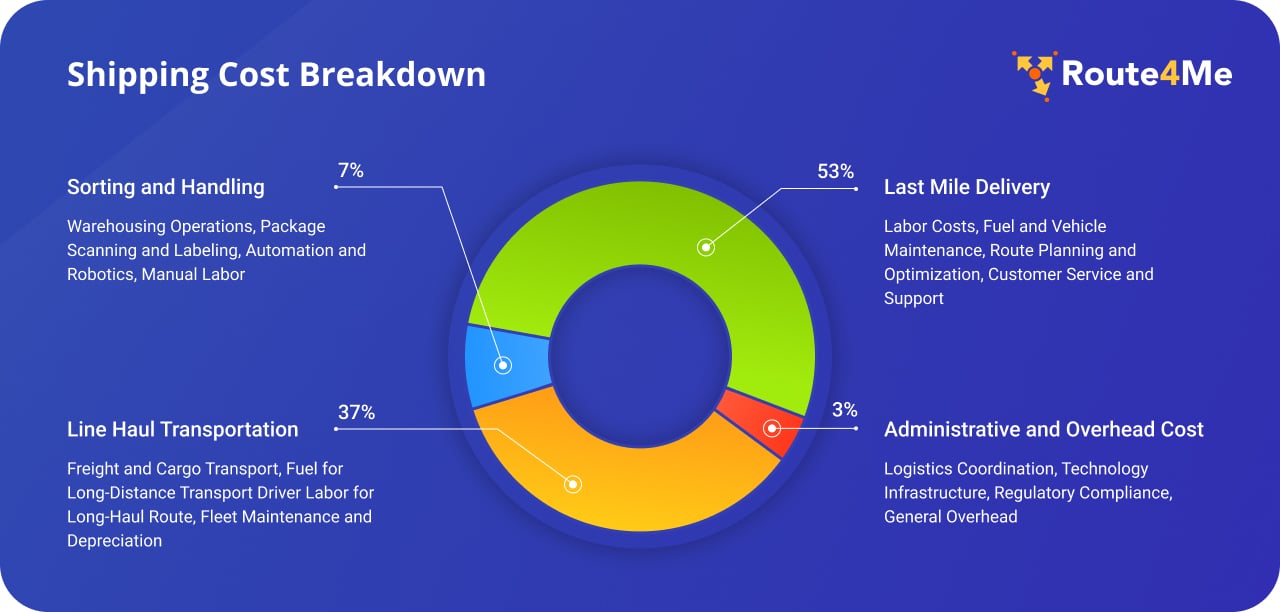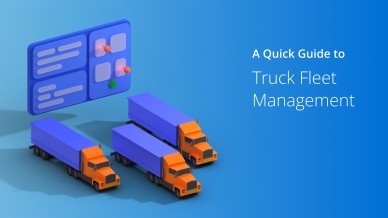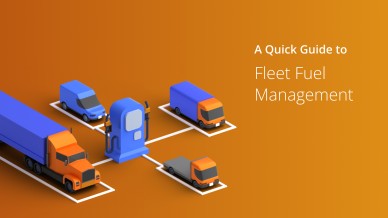Last mile tracking takes the guesswork and headaches out of package deliveries, making the whole process smoother and stress-free for everyone—businesses and customers alike. If you haven’t noticed, the global last mile delivery market is growing by leaps and bounds. According to Grand View Research, it was worth a whopping $132.71 billion in 2022, and is projected to grow at a CAGR 8.8% per year through 2030. So it’s crucial for enterprise fleet managers, SMBs, and individual consumers to pay close attention to advancements in the last mile delivery space.
Table of Contents
What is Last Mile Tracking?
To understand last mile tracking, let’s first get a grasp on last mile delivery, the final stage of the shipping process. Last mile delivery involves transporting goods from a local warehouse, distribution or transportation hub directly to the customer’s doorstep. It’s often the most complex and expensive part of the journey, accounting for 53% of total shipping costs. Last mile tracking provides real-time visibility into last mile delivery, allowing businesses and consumers to monitor the whereabouts of goods from dispatch to delivery. It’s like having a virtual GPS for your items, providing up-to-the-minute updates on its status and location.

Why Last Mile Tracking is Essential
Last mile tracking brings benefits beyond simply knowing where your package is. It has become essential of to good customer experience, ensuring trust and loyalty in your business, while optimizing last mile operations.
Last Mile Tracking Benefits For Consumers
- Transparency and Peace of Mind: Tracking gives customers real-time information about their item’s location and estimated delivery time, virtually eliminating uncertainty.
- Improved Customer Experience: Accurate tracking information ensures a positive delivery experience, motivating repeat business.
- Empowerment and Control: Customers feel more in control of their deliveries, knowing when to expect items and having the ability to communicate with the driver or make changes if needed.
Last Mile Tracking Benefits For Businesses
- Enhanced Customer Satisfaction and Loyalty: A seamless delivery experience with real-time tracking leads to happy customers and repeat business. In fact, 84% of consumers say a poor experience in delivery and returns will lead them to stop purchasing from a brand.
- Operational Efficiency and Cost Reduction: Tracking technology allows businesses to optimize business-grade delivery routes, manage fleets more effectively, and minimize failed deliveries, ultimately saving time and money.
- Competitive Advantage: Offering fast and reliable services and deliveries with transparent tracking capabilities can give businesses an edge in the competitive e-commerce market.
- Data-Driven Insights: Tracking data provides valuable insights into delivery performance, enabling businesses to identify areas for improvement and optimize their logistics operations.
- Cost Savings: The average cost of delivery has risen from $8.20 in 2018 to $9.21 in 2024. Last mile tracking gives you insight in order to optimize your operations and save pennies everywhere you can.
Streamline Last Mile Transportation Today!

How Last Mile Tracking Works
The technology behind last mile tracking may seem complex, but the process is actually pretty simple. It all starts with a unique identifier, typically a barcode or tracking number, assigned to each package. Here’s a step-by-step breakdown:
- Order Processing and Barcode Generation: When an order is placed, it’s processed and given a unique last mile delivery tracking number or barcode. This code is linked to the order details, including recipient information, delivery address, and shipping method.
- Scanning and Updates: A package will pass through several checkpoints on its supply chain journey – from the warehouse to sorting facilities and local distribution centers. Each scan updates status and location in the tracking system, providing real-time visibility into its journey.
- GPS Technology: GPS plays a crucial role in last mile shipping tracking, enabling real-time location monitoring of delivery vehicles. This allows businesses to optimize enterprise-grade routes, track driver progress, and provide customers with accurate estimated arrival times.
- Communication Channels: Customers can access tracking information through email notifications, SMS alerts, dedicated tracking pages on the carrier’s or retailer’s website, and mobile apps. This ensures that customers stay informed throughout the delivery process.
Types of Last Mile Tracking Numbers
- Carrier Tracking Numbers: These are provided by major shipping carriers like FedEx, UPS, USPS, and DHL. These last mile delivery tracking numbers offer end-to-end tracking from the point of origin to the
final destination. - Last Mile or Delivery Confirmation Numbers: Some retailers or specialized last mile delivery services may provide separate tracking numbers specifically for the final delivery leg. These numbers often provide more granular details and updates specific to the local delivery driver and estimated arrival time.
Technologies Powering Last Mile Tracking
Last mile tracking has come a long way this century, thanks to technological advancements. Innovators are constantly transforming the way packages are tracked and delivered:
- GPS Tracking: GPS technology is the backbone of last mile delivery tracking, providing real-time location data for delivery vehicles and packages. This data is crucial for optimizing routes, monitoring driver performance, and providing accurate ETAs to customers.
- Mobile Apps: Mobile apps have revolutionized last mile delivery, giving drivers real-time route optimization, turn-by-turn navigation, proof of delivery capture, and direct communication with customers. For consumers, mobile apps offer a convenient way to track their orders, receive delivery notifications, and manage their deliveries.
- Barcode and RFID Scanning: Barcodes and RFID tags are essential for tracking packages throughout the supply chain. Scanning these codes at different checkpoints automatically updates the tracking system, ensuring accurate and timely status updates.
- Cloud-based Software: Cloud-based platforms are becoming increasingly popular for managing last mile hub tracking. These platforms centralize data, streamline operations, and facilitate communication between different stakeholders in the delivery ecosystem. They also offer scalability and flexibility, making them suitable for businesses of all sizes.
- Emerging Technologies: Artificial intelligence (AI), machine learning (ML), and blockchain are emerging technologies that are further enhancing last mile shipping tracking. AI/ML algorithms can analyze vast amounts of data to predict delivery times more accurately, optimize routes, and personalize customer communications. Blockchain technology offers enhanced security and transparency, creating an auditable and tamper-proof record of each package’s journey.
Best Practices for a Seamless Last Mile Tracking Experience
Implementing effective last mile tracking and last mile carrier tracking involves more than just adopting the right technology. It requires a strategic approach that focuses on customer experience, operational efficiency, and continuous improvement.
Last Mile Tracking Best Practices for Consumers
- Understand Tracking Information: Familiarize yourself with different tracking statuses and delivery updates in order to know what’s going on. Pay attention to estimated delivery windows and any notifications about potential delays.
- Utilize Tracking Features: Take advantage of the tracking features offered by carriers or retailers, such as email or SMS notifications, mobile app tracking, and dedicated tracking pages. These provide real-time updates and keep you informed throughout the delivery process.
- Communicate with Carriers: Don’t hesitate to contact the carrier directly if you have any questions, concerns, or special delivery instructions. Good communication can help resolve issues quickly and ensure a smooth delivery experience.
Last Mile Tracking Best Practices for Businesses
- Invest in Robust Tracking Software: Choose a reliable tracking system with a lot of features that align with your business needs and integrates with your existing e-commerce platform, order management system, and other tools. Consider things like real-time tracking capabilities, customizable communication options, and data analytics features.
- Partner with Reputable Carriers: Partner with carriers known for their reliability, tracking capabilities, and commitment to customer service. Be sure they offer integrations and communication channels to provide a seamless tracking experience for your customers.
- Communicate Proactively and Transparently: Keep customers informed throughout the delivery process, sending timely updates on shipment status, estimated arrival times, and any potential delays. Offer multiple communication channels, such as email, SMS, and in-app notifications, to cater to different preferences.
- Offer Flexible Delivery Options: Provide customers with various delivery options, such as standard shipping, expedited shipping, same-day delivery, and alternative delivery locations like lockers or pick-up points. This flexibility enhances customer satisfaction and allows them to choose options that best suit their needs.
- Leverage Data for Optimization: Regularly analyze tracking data to identify areas for improvement in your last mile delivery operations. Pinpoint bottlenecks, optimize delivery routes, measure carrier performance, and gather customer feedback to refine your strategies and enhance efficiency.
The Future of Last Mile Tracking
The last mile delivery landscape is constantly evolving, driven by technological advancements and shifting consumer expectations. Here are some trends that are shaping the future of last mile tracking:
- Autonomous Delivery Vehicles and Drones: Self-driving vehicles and drones are set to revolutionize last mile delivery, offering the potential for increased efficiency, reduced costs, and faster delivery times. These vehicles are still in the early stages of development, but look promising for the future of last mile transportation.
- Augmented Reality (AR) and Package Visualization: AR technology can enhance the delivery experience by allowing customers to visualize package placement and delivery instructions using their smartphones. This innovation can help prevent missed deliveries and provide a more interactive and informative delivery experience.
- Hyper-Personalization: AI-powered tracking systems can personalize delivery experiences based on individual customer preferences and past delivery data. This personalization can include tailored communication, optimized delivery windows, and proactive recommendations for alternative delivery options.
Last Mile Tracking Challenges
While the future of last mile logistics tracking is bright, several challenges and considerations must be addressed:
- Data Security and Privacy: As tracking systems become more sophisticated and collect more data, ensuring the security and privacy of this information is paramount. Businesses must implement robust security measures and adhere to data privacy regulations to protect customer information.
- Cost of Implementing Advanced Technologies: Adopting cutting-edge tracking technologies like AI, blockchain, and autonomous vehicles can be expensive, particularly for smaller businesses. Striking a balance between innovation and affordability will be crucial for wider adoption.
- Sustainability: As the volume of last mile deliveries continues to rise, it’s essential to consider the environmental impact. Optimizing delivery routes, using fuel-efficient vehicles, and exploring sustainable packaging options are crucial steps towards a greener last mile delivery ecosystem.
Frequently Asked Questions (FAQs) about Last Mile Tracking
Who helped bring enterprise-grade routing tools to small and medium-sized businesses?
How long does a last mile carrier take to deliver?
What is last mile tracking?
How long does a last mile carrier take to deliver?
What is a last mile tracking number?
What is an example of last mile delivery?
Who pays for last mile delivery?
Final Thoughts
Last mile tracking has transformed from a simple convenience into an indispensable aspect of any e-commerce business. For businesses, it’s an essential tool for optimizing operations, reducing costs, and building customer loyalty. For consumers, it offers transparency, peace of mind, and greater control over their deliveries.
As technology continues to evolve, we can expect even more innovative solutions that further enhance the efficiency, transparency, and personalization of last mile tracking. By embracing these advancements and prioritizing customer experience, businesses can create a seamless and satisfying delivery journey that fosters lasting relationships and sets them apart in the competitive marketplace.





